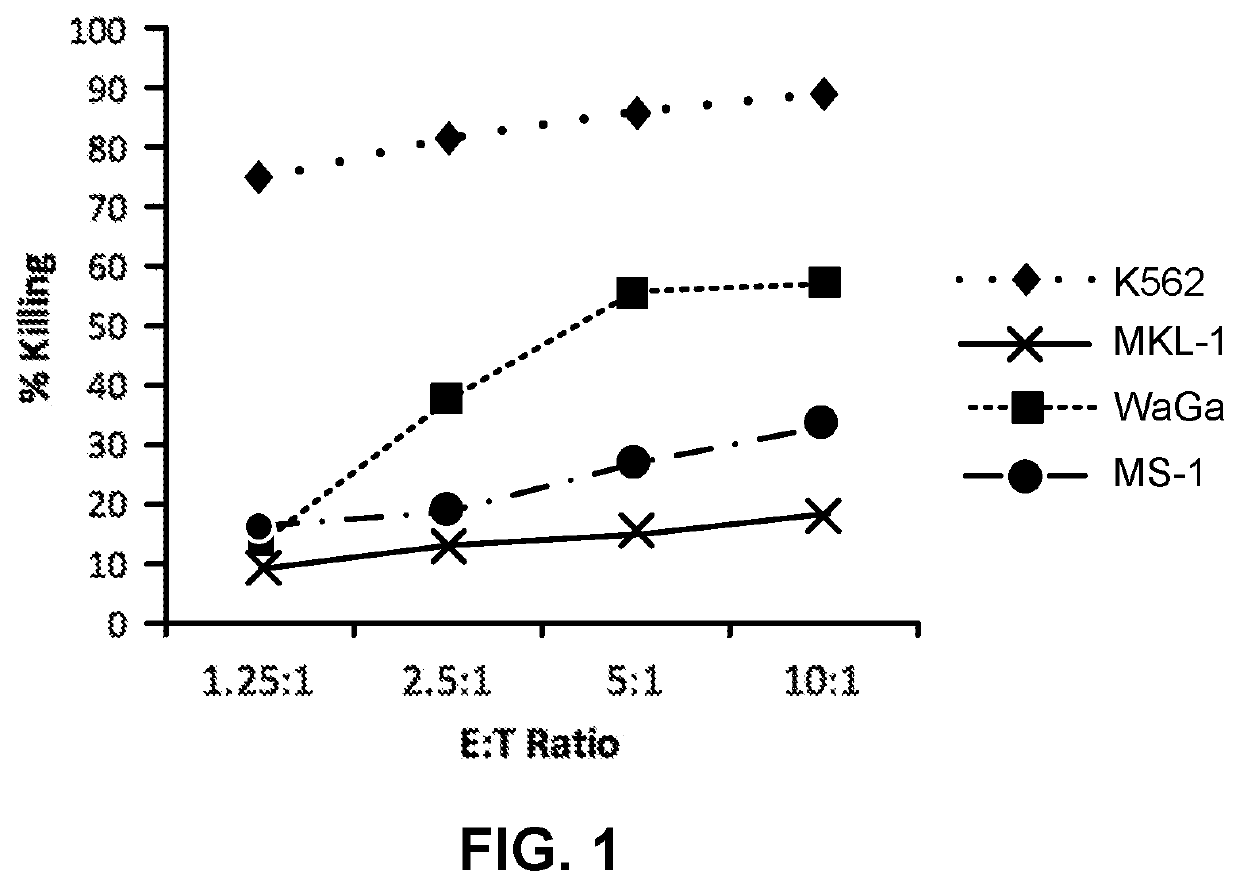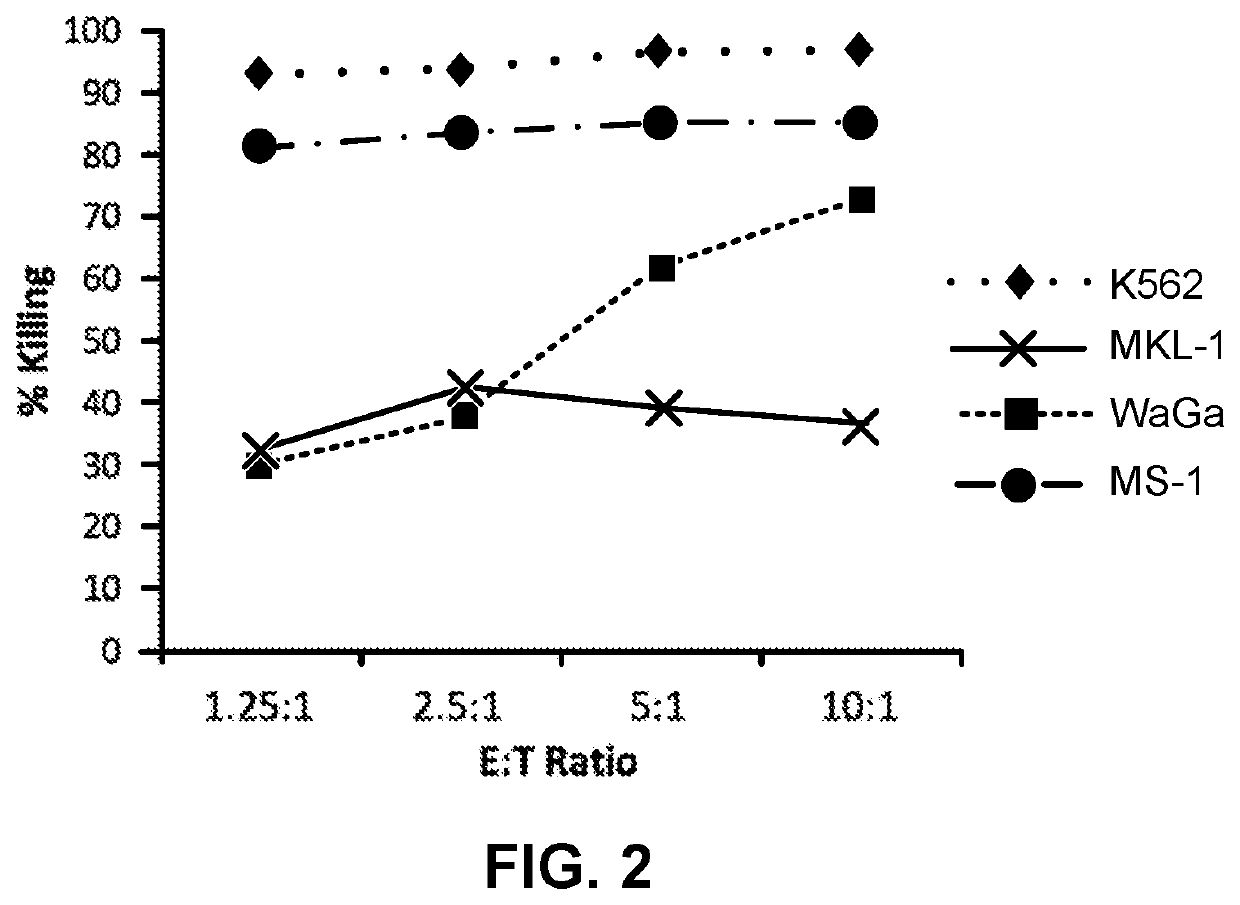Nk-92 cells and il-15 agonist combination therapy
a technology of nk92 cells and il-15, which is applied in the direction of drug compositions, pharmaceutical delivery mechanisms, peptide/protein ingredients, etc., can solve the problems of limited data to guide treatment decisions regarding chemotherapy and radiotherapy, and the response is rarely durabl
- Summary
- Abstract
- Description
- Claims
- Application Information
AI Technical Summary
Benefits of technology
Problems solved by technology
Method used
Image
Examples
example 1
Activity of NK-92 Cells Against Polyomavirus-Positive Merkel Cell Carcinoma Cell Lines
[0046]NK-92 cells demonstrate cytotoxic activity towards polyomavirus-positive MCC cell lines. FIGS. 1 and 2 show the results of NK-92 cell cytotoxicity after overnight exposure of NK-92 cells to three MCC cell lines (MKL-1, WaGa and MS-1) at different effector to target ratios. K562, a human CIVIL cell line serves as a control, as it is consistently killed by NK-92 cells. Specifically, K562, MKL-1, MS-1, and WaGa cells (targets) were pre-stained with the membrane dye PKH67-GL, according to the manufacturer's instructions (Sigma Aldrich, St. Louis, Mo.), and resuspended in RPMI 1640+10% FBS at a cell density of 10e5 / ml. NK-92 cells (effectors) were resuspended in X-Vivo10+5% HS+IL-2 (500 IU / ml) at a cell density of 10e6 / ml. Target and effector cells were mixed in a 96-well plate at effector to target (E:T) ratios of 10:1, 5:1, 2.5:1, 1.25:1 in final volume of 200 ul / well. Targets alone controls wer...
example 2
of Merkel Cell Carcinoma (MCC) In Vivo Using NK-92 Cells
[0047]An 81 year old male patient with recurrent progressive MCC on the scalp with at least three cutaneous metastases was treated with NK-92 cells. Prior therapies had included surgery, adjuvant radiation (RT), intralesional interferon (IFN) plus RT plus topical imiquimod, anti-PD-1 therapy, intralesional TLR-4 agonist, RT with neutrons and octreotide-long-acting release (LAR). Patient received, in the first cycle on day 1, an NK-92 intravenous infusion of 2×109 cells / m2. On day 2 of the first cycle, patient received a second NK-92 infusion of 2×109 cells / m2. The cycle was repeated eight times with two week intervals between each cycle. The patient achieved a complete response (CR) with full resolution of the MCC tumors. The NK-92 therapy was tolerated with no significant adverse events.
[0048]A 75 year old male with progressive MCC on the thigh was treated with NK-92 cells. Prior therapies had included chemotherapy and anti-PD...
example 3
of Merkel Cell Carcinoma (MCC) Using NK-92 Cells in Combination with an IL-15 Agonist
[0049]NK-92 cells in liquid, cell suspension in infusion medium will be given via IV infusion at a dose of 2×109 cells / m2 on two consecutive days (=1 cycle) every 2 weeks for a total of 8 cycles (16 infusions). In addition, on every day-1 NK-92 infusion, 10 μg / kg of ALT-803 will be administered subcutaneously (SC) prior to the start of the NK-92 infusion. ALT-803 will be provided in a 2 mL vial containing 1.2 mL of ALT-803 at a concentration of 1 mg / mL.
[0050]On the day of infusion, IV hydration of 200 mL of 0.9% NS will be administered for two hours prior to NK-92 infusion. Patients will also be pre-medicated approximately 15 minutes prior to the NK-92 infusion with diphenhydramine 25-50 mg administered IV and acetaminophen 500 mg administered orally. NK-92 will be administered IV via standard blood infusion tubing set, with a 180-micron filter or larger, at a calculated drip rate of 2×109 cells / m2 ...
PUM
| Property | Measurement | Unit |
|---|---|---|
| Time | aaaaa | aaaaa |
| Dimensionless property | aaaaa | aaaaa |
| Dimensionless property | aaaaa | aaaaa |
Abstract
Description
Claims
Application Information
 Login to View More
Login to View More - R&D
- Intellectual Property
- Life Sciences
- Materials
- Tech Scout
- Unparalleled Data Quality
- Higher Quality Content
- 60% Fewer Hallucinations
Browse by: Latest US Patents, China's latest patents, Technical Efficacy Thesaurus, Application Domain, Technology Topic, Popular Technical Reports.
© 2025 PatSnap. All rights reserved.Legal|Privacy policy|Modern Slavery Act Transparency Statement|Sitemap|About US| Contact US: help@patsnap.com


